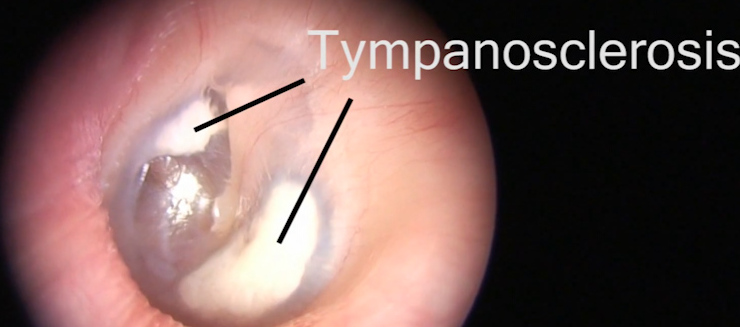Tympanosclerosis

Editor-In-Chief: Prab R Tumpati, MD
Obesity, Sleep & Internal medicine
Founder, WikiMD Wellnesspedia &
W8MD medical weight loss NYC and sleep center NYC
| Tympanosclerosis | |
|---|---|

| |
| Synonyms | Myringosclerosis |
| Pronounce | N/A |
| Specialty | N/A |
| Symptoms | Hearing loss, tinnitus |
| Complications | Conductive hearing loss |
| Onset | Variable |
| Duration | Chronic |
| Types | N/A |
| Causes | Chronic otitis media, ear infections |
| Risks | Recurrent ear infections, ear surgery |
| Diagnosis | Otoscopy, audiometry |
| Differential diagnosis | Otosclerosis, cholesteatoma |
| Prevention | Treating ear infections promptly |
| Treatment | Hearing aids, surgery |
| Medication | None specific |
| Prognosis | Variable, may lead to permanent hearing loss |
| Frequency | Common in individuals with chronic ear infections |
| Deaths | N/A |
A condition affecting the tympanic membrane and middle ear
Tympanosclerosis is a condition characterized by the calcification and scarring of the tympanic membrane (eardrum) and sometimes the middle ear structures. It is often associated with chronic otitis media and can lead to conductive hearing loss.
Pathophysiology[edit]
Tympanosclerosis occurs when there is a deposition of hyaline and calcified plaques in the tympanic membrane and the middle ear. This process is thought to be a result of chronic inflammation, often following repeated episodes of otitis media. The calcification can lead to stiffening of the eardrum and ossicular chain, impairing their ability to transmit sound.
Clinical Presentation[edit]
Patients with tympanosclerosis may present with symptoms of hearing loss, which is typically conductive in nature. The degree of hearing loss can vary depending on the extent of the calcification and involvement of the ossicular chain. Some patients may also experience tinnitus or a sensation of fullness in the ear.
Diagnosis[edit]
Diagnosis of tympanosclerosis is primarily clinical, based on otoscopic examination. The eardrum may appear thickened and opaque, with visible white plaques. Audiometry can be used to assess the degree of hearing loss and to differentiate between conductive and sensorineural components.
Treatment[edit]
Treatment of tympanosclerosis is generally conservative, focusing on managing symptoms. Hearing aids may be used to improve hearing in patients with significant conductive hearing loss. In some cases, surgical intervention, such as tympanoplasty or ossicular chain reconstruction, may be considered to improve hearing.
Prognosis[edit]
The prognosis for patients with tympanosclerosis varies. While the condition itself is not progressive, the associated hearing loss can impact quality of life. Early intervention and management can help mitigate the effects on hearing.
See also[edit]
Ad. Transform your life with W8MD's Budget GLP-1 injections from $75


W8MD offers a medical weight loss program to lose weight in Philadelphia. Our physician-supervised medical weight loss provides:
- Weight loss injections in NYC (generic and brand names):
- Zepbound / Mounjaro, Wegovy / Ozempic, Saxenda
- Most insurances accepted or discounted self-pay rates. We will obtain insurance prior authorizations if needed.
- Generic GLP1 weight loss injections from $75 for the starting dose.
- Also offer prescription weight loss medications including Phentermine, Qsymia, Diethylpropion, Contrave etc.
NYC weight loss doctor appointmentsNYC weight loss doctor appointments
Start your NYC weight loss journey today at our NYC medical weight loss and Philadelphia medical weight loss clinics.
- Call 718-946-5500 to lose weight in NYC or for medical weight loss in Philadelphia 215-676-2334.
- Tags:NYC medical weight loss, Philadelphia lose weight Zepbound NYC, Budget GLP1 weight loss injections, Wegovy Philadelphia, Wegovy NYC, Philadelphia medical weight loss, Brookly weight loss and Wegovy NYC
|
WikiMD's Wellness Encyclopedia |
| Let Food Be Thy Medicine Medicine Thy Food - Hippocrates |
Medical Disclaimer: WikiMD is not a substitute for professional medical advice. The information on WikiMD is provided as an information resource only, may be incorrect, outdated or misleading, and is not to be used or relied on for any diagnostic or treatment purposes. Please consult your health care provider before making any healthcare decisions or for guidance about a specific medical condition. WikiMD expressly disclaims responsibility, and shall have no liability, for any damages, loss, injury, or liability whatsoever suffered as a result of your reliance on the information contained in this site. By visiting this site you agree to the foregoing terms and conditions, which may from time to time be changed or supplemented by WikiMD. If you do not agree to the foregoing terms and conditions, you should not enter or use this site. See full disclaimer.
Credits:Most images are courtesy of Wikimedia commons, and templates, categories Wikipedia, licensed under CC BY SA or similar.
Translate this page: - East Asian
中文,
日本,
한국어,
South Asian
हिन्दी,
தமிழ்,
తెలుగు,
Urdu,
ಕನ್ನಡ,
Southeast Asian
Indonesian,
Vietnamese,
Thai,
မြန်မာဘာသာ,
বাংলা
European
español,
Deutsch,
français,
Greek,
português do Brasil,
polski,
română,
русский,
Nederlands,
norsk,
svenska,
suomi,
Italian
Middle Eastern & African
عربى,
Turkish,
Persian,
Hebrew,
Afrikaans,
isiZulu,
Kiswahili,
Other
Bulgarian,
Hungarian,
Czech,
Swedish,
മലയാളം,
मराठी,
ਪੰਜਾਬੀ,
ગુજરાતી,
Portuguese,
Ukrainian